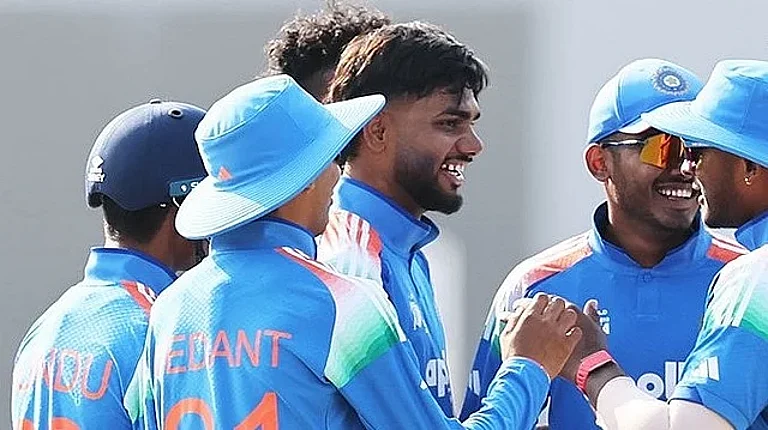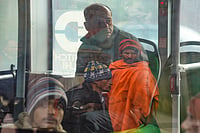
But the demand for such traditional saris is fast dwindling. "They now have a sari that even has a pouch for your mobile, another which has a battery-operated device that sings!" shudders Shanta Guhan, whose involvement with the Crafts Council of India has brought her up close and personal with weavers for many decades. "If I had Rs 40 lakh, I'd invest in jewellery," says Guhan. She was commenting on the Rs 40-lakh sari recently created by Chennai Silks, which has Raja Ravi Verma's Lady Musicians woven on the pallu, 10 of his other paintings on the border and 12 precious stones and gems including a diamond, emeralds, sapphires, rubies and pearls, scattered all over. "The most valuable sari on earth, the most invaluable craftsmanship ever," declares the ad for the sari which has had its share of gawkers at the Chennai Silks showroom in T'nagar, and is now on a five-city tour including Coimbatore, Tiruppur, Erode and Trichy.
The demand for glitzy, pricey, bling-laden Kanchipuram saris with "innovative" (Guhan would call them outlandish) new designs is growing. During Diwali last month, shoppers thronged Chennai's newer silk emporiums such as Rmkv's, Pothys and Chennai Silks that stock such saris, and are giving traditional establishments like Nalli, Kumaran and Sundari Silks a run for their money. Recently, a Canada-based Sri Lankan shelled out Rs 50,000 for Rmkv's piece de resistance—the 50,000-shade sari (a spectrophotometer was used to come up with the different shades). It's another matter altogether that G. Lakshmipathy, who weaves silk saris in his home in one of the crowded lanes of Kanchipuram, says that silk only comes in 24 shades and anyone who says otherwise is lying!
But Rmkv's made it to the Guinness Book of World Records with its 50,000-shade sari. It was in Guinness in 2004 as well for the world's longest sari at 702 ft, while Pothys made it the following year with its 1,276-ft-long sari that depicted 5,000 years of Indian civilisation. There is a growing culture of consumerism in Chennai, and these new players are cashing in on it. Even aadi masam, the July-August season when everyone is supposed to observe a self-imposed Lent-like ban on purchases, has now turned into a shopping frenzy ("aadi galatta") with the new sari shops offering irresistible discounts during this season. And if earlier it was only for family weddings that people spent big money on saris, today the sari-buying season is all the year round. "Women must have a pattu paduvai (silk sari) for Deepavali, for Pongal, for someone's else's wedding, a christening, an engagement, birthdays, even Christmas," a customer at a sari store told Outlook.
A reversible sari that can be worn four different ways—it has four pallus, four matching borders and two body colours—launched by Rmkv's last year, was priced at Rs 68,000 but sold almost immediately. "Price is never an impediment when a woman spots a sari she wants," laughs M. Vishwanathan, one of the three brothers at Dhinakaran Silk House, founded by their father, 87-year-old Singaru Mudaliar, 60 years ago.

Among the fast-moving items these days are brocade saris that weigh as much as 2 kg with a painting done in zari on the pallu, priced at Rs 40,000. Chennai Silks' Rs 40,000 offering is a silk sari with a thousand flowers, which their salesmen say is another "fast-moving item". Even little girls are now rejecting the traditional silk skirts. "My daughter pestered me for a pavadai with Cinderella/ Snow White motifs done on the border and it cost me Rs 2,500," reveals one mother. When Devika bought her maid a traditional silk sari for Diwali, she wanted money instead so she that could get something more modern and jazzy.

And this being the season when NRIs visit, expensive saris are selling faster than weavers can make them. "You can be sure that saris which come with a price tag of Rs 2 to 3 lakh are hanging in the wardrobe of an NRI from Canada, UK or Malaysia," a Kanchipuram weaver told Outlook. One NRI, Munimma, confessed in a blog, "Rmkv's was one of my haunts during my last trip to Chennai. I think I must have spent a half-year's salary there."
Arundhati Menon, who runs Shilpi, a fashionable boutique in upscale Nungambakkam, says she knows quite a few people who would dish out Rs 40 lakh for Chennai Silks' latest sari sensation. One shopper at Chennai Silks says she was told, "Without the precious stones we'll give you the sari for Rs 2.5 lakh." That might happen once the guarded proprietors—eight media-shy brothers who all have the title of managing director—have got the Rs 40 lakh sari into the record books. A spokesman for Chennai Silks adds, "We did the Raja Ravi Varma sari to give weavers a morale boost." "I don't buy that," responds Shanta Guhan. "If you want so showcase an artisan's skills, get young people to wear saris. Make them so beautiful as to be irresistible."
Meanwhile, the weavers who make these high-priced creations are struggling to survive. Of the 24 cooperative silk societies in Kanchipuram, 13 are sick. Weavers complain that they can barely make ends meet, let alone educate their children. As Lalitha, the teenage daughter of weaver Lakshmipathy, says, "In 25 years at the loom, after labouring to produce three saris a month, my father still can't afford to send me to college." Some warped weft this is.


























